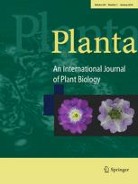Two strains each of Streptomyces albus (CAI-17 and KAI-27) and Streptomyces griseus (KAI-26 and MMA-32) and one strain of Streptomyces cavourensis (SAI-13) previously reported to have plant growth-promotion activity in chickpea, rice and sorghum were evaluated for their antagonistic potential against Macrophomina phaseolina, which causes charcoal rot in sorghum. The antagonistic potential of these strains against M. phaseolina was assessed through dual culture assay, metabolite production assay, blotter paper assay in greenhouse and field disease screens. In both dual culture and metabolite production assays, the selected strains significantly inhibited the growth of M. phaseolina (63–74%). In the blotter paper assay, all the five strains of Streptomyces spp. inhibited the pathogen (80–90%). When these five strains were tested for their antagonistic potential under the greenhouse (two times) and field (two seasons) conditions by toothpick method of inoculation, significant differences were observed for charcoal rot severity. Principal component analysis capturing 91.3% phenotypic variations, revealed that the shoot samples treated with both Streptomyces and the pathogen exhibited significantly enhanced antioxidant parameters including superoxide dismutase, catalase, ascorbate peroxidase, guaiacol peroxidase, glutathione reductase, phenylalanine ammonia-lyase, polyphenol oxidase, and total phenolic contents when compared to shoot samples treated with only M. phaseolina. Scanning electron microscope analysis revealed that the phloem and xylem tissues of the Streptomyces treated stem samples were intact compared to that of pathogen inoculated plants. This study indicated that the selected strains of Streptomyces spp. have the potential for biological control of charcoal rot disease in sorghum.

